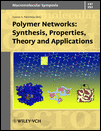Anisotropic Epoxy Networks
Beata Mossety Leszczak
Department of Industrial and Materials Chemistry, Faculty of Chemistry, Rzeszów University of Technology, W. Pola 2, 35-959 Rzeszów, Poland
Search for more papers by this authorCorresponding Author
Henryk Galina
Department of Industrial and Materials Chemistry, Faculty of Chemistry, Rzeszów University of Technology, W. Pola 2, 35-959 Rzeszów, Poland
Department of Industrial and Materials Chemistry, Faculty of Chemistry, Rzeszów University of Technology, W. Pola 2, 35-959 Rzeszów, Poland. Fax: +48 (017) 854 36 55Search for more papers by this authorMagdalena Włodarska
Institute of Physics, Technical University of Łódź, Wólczańska 119, 90-924 Łódź, Poland
Search for more papers by this authorUrszula Szeluga
Centre of Polymer and Carbon Materials, Polish Academy of Sciences, Sowińskiego 5, 44-121 Gliwice, Poland
Search for more papers by this authorHieronim Maciejewski
Department of Organometallic Chemistry, Faculty of Chemistry, Adam Mickiewicz University, Grunwaldzka 6, 60-780 Poznań, Poland
Search for more papers by this authorBeata Mossety Leszczak
Department of Industrial and Materials Chemistry, Faculty of Chemistry, Rzeszów University of Technology, W. Pola 2, 35-959 Rzeszów, Poland
Search for more papers by this authorCorresponding Author
Henryk Galina
Department of Industrial and Materials Chemistry, Faculty of Chemistry, Rzeszów University of Technology, W. Pola 2, 35-959 Rzeszów, Poland
Department of Industrial and Materials Chemistry, Faculty of Chemistry, Rzeszów University of Technology, W. Pola 2, 35-959 Rzeszów, Poland. Fax: +48 (017) 854 36 55Search for more papers by this authorMagdalena Włodarska
Institute of Physics, Technical University of Łódź, Wólczańska 119, 90-924 Łódź, Poland
Search for more papers by this authorUrszula Szeluga
Centre of Polymer and Carbon Materials, Polish Academy of Sciences, Sowińskiego 5, 44-121 Gliwice, Poland
Search for more papers by this authorHieronim Maciejewski
Department of Organometallic Chemistry, Faculty of Chemistry, Adam Mickiewicz University, Grunwaldzka 6, 60-780 Poznań, Poland
Search for more papers by this authorAbstract
We present the synthesis, characteristics and curing process of liquid crystalline epoxy monomers containing a central triaromatic mesogenic group. The epoxy monomers were cross-linked with aromatic amines or dicarboxylic acids. In most cases, solid, thermally stable and anisotropic products were obtained. The curing reactions of the monomer were also carried out with selected fillers. The cross-linking process of the composites was monitored by differential scanning calorimetry and dielectric relaxation spectroscopy to compare with analogous liquid crystalline systems not containing filler. Some properties of the cured resin and the composites are described and discussed.
References
- 1 A. Shiota, C. K. Ober, Prog. Polym. Sci. 1997, 22, 975.
- 2 C. Carfagna, E. Amendola, M. Giamberini, Prog. Polym. Sci. 1997, 22, 1607.
- 3 E. P. Douglas, J. Macromol. Sci., Part C: Polym. Rev. 2006, 46, 127.
- 4 M. Donald, A. H. Windle, “ Liquid Crystalline Polymers,” Cambridge University Press, 1992.
- 5
T.-S. Chung,
“ Thermotropic Liquid Crystal Polymers: Thin-film Polymerization, Characterization, Blend, and Applications,”
Technomic Publishers,
Lancaster
2001.
10.1201/9781420012521 Google Scholar
- 6 G. G. Barclay, C. K. Ober, K. I. Papathomas, D. W. Wang, J. Polym. Sci., Part A: Polym. Chem. 1992, 30, 1831.
- 7 S. Jahromi, J. Lub, G. N. Mol, Polymer 1994, 35, 622.
- 8 S. Jahromi, Macromolecules 1994, 27, 2804.
- 9 D. J. Broer, J. Lub, G. N. Mol, Macromolecules 1993, 26, 1244.
- 10 M. Giamberini, E. Amendola, C. Carfagna, Mol. Cryst. Liq. Cryst. 1995, 266, 9.
- 11 G. Liu, J. Gao, L. Song, W. Hou, L. Zhang, Macromol. Chem. Phys. 2006, 207, 2222.
- 12
A. Rozenberg,
L. L. Gur'eva, in
Synthesis, Characterization and Theory of Polymeric Networks and Gels;
S. M. Aharony, Ed.,
Plenum,
New York
1992,
147.
10.1007/978-1-4615-3016-9_11 Google Scholar
- 13 M. Harada, M. Ochi, M. Tobita, T. Kimura, T. Ishigaki, N. Shimoyama, H. Aoki, J. Polym. Sci., Part B: Polym. Phys. 2004, 42, 758.
- 14 J. Y. Lee, J. Jang, Polymer 2006, 47, 3036.
- 15
W. Mormann,
M. Bröcher,
Macromol. Chem. Phys.
1998,
199,
853.
10.1002/(SICI)1521-3935(19980501)199:5<853::AID-MACP853>3.0.CO;2-S CAS Web of Science® Google Scholar
- 16 P. Castell, M. Galià, A. Serra, Macromol. Chem. Phys. 2001, 202, 1649.
- 17 D. Ribera, M. Giamberini, A. Serra, A. Mantecón, J. Polym. Sci., Part A: Polym. Chem. 2006, 44, 6270.
- 18 H. Galina, B. Mossety-Leszczak, J. Appl. Polym. Sci. 2007, 105, 224.
- 19 V. Ambrogi, M. Giamberini, P. Cerruti, P. Pucci, N. Menna, R. Mascolo, C. Carfagna, Polymer 2005, 46, 2105.
- 20 C. Carfagna, D. Acierno, V. Di Palma, E. Amendola, M. Giamberini, Macromol. Chem. Phys. 2000, 201, 2631.
- 21 J. Bae, J. Jang, S.-H. Yoon, Macromol. Chem. Phys. 2002, 203, 2196.
- 22 M.-M. Shen, M.-G. Lu, Y.-L. Chen, C.-Y. Ha, Polym. Int. 2005, 54, 1163.
- 23 J. Jang, J. Bae, K. Lee, Polymer 2005, 46, 3677.
- 24 A. Strachota, P. Whelan, J. Kříž, J. Brus, M. Urbanová, M. Šlouf, L. Matějka, Polymer 2007, 48, 3041.
- 25 J. Choi, J. Harcup, A. F. Yee, Q. Zhu, R. M. Laine, J. Am. Chem. Soc. 2001, 123, 11420.
- 26 C. Carfagna, G. Meo, L. Nicolais, M. Giamberini, A. Priola, G. Malucelli, Macromol. Chem. Phys. 2000, 201, 2639.




